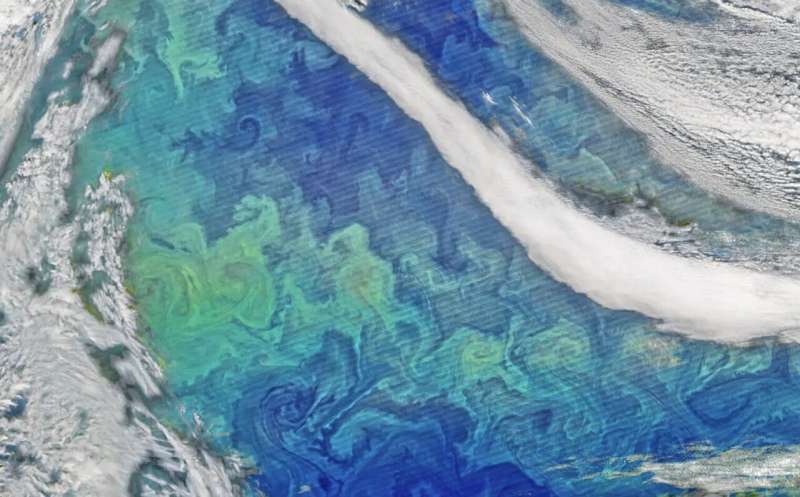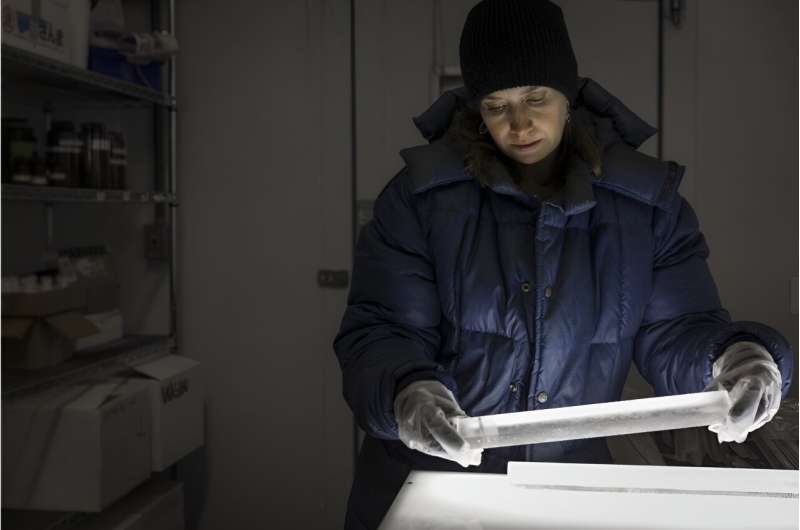This article has been reviewed according to Science X's editorial process and policies. Editors have highlighted the following attributes while ensuring the content's credibility:
fact-checked
peer-reviewed publication
trusted source
proofread
North Atlantic's marine productivity may not be declining, according to new study of older ice cores

To paraphrase Mark Twain, reports of declining phytoplankton in the North Atlantic may have been greatly exaggerated. A prominent 2019 study used ice cores in Antarctica to suggest that marine productivity in the North Atlantic had declined by 10% during the industrial era, with worrying implications that the trend might continue.
But new research led by the University of Washington shows that marine phytoplankton—on which larger organisms throughout the marine ecosystem depend—may be more stable than believed in the North Atlantic. The team's analysis of an ice core going back 800 years shows that a more complex atmospheric process may explain the recent trends.
The study was published in the Proceedings of the National Academy of Sciences.
Tiny floating photosynthetic organisms known as phytoplankton form the base of the marine ecosystem. These microscopic creatures are also important to the planet as a whole, producing roughly half the oxygen in Earth's atmosphere.
Since phytoplankton are hard to count, scientists attempt to measure their abundance in other ways. Phytoplankton emit dimethyl sulfide, an odorous gas that gives beaches their distinctive smell. Once airborne, the dimethyl sulfide converts to methanesulfonic acid, or MSA, and sulfate. These eventually fall out onto land or snow, making ice cores one way to measure past population sizes.

"Greenland ice cores show a decline in MSA concentrations over the industrial era, which was concluded to be a sign of declining primary productivity in the North Atlantic," said lead author Ursula Jongebloed, a UW doctoral student in atmospheric sciences. "But our study of sulfate in a Greenland ice core shows that MSA alone can't tell us the whole story when it comes to primary productivity."
Since the mid-1800s, factories and tailpipes have also been spewing sulfur-containing gases into the air. Those gases have slightly different forms of sulfur atoms that make it possible to distinguish the marine and land-based sources in ice cores.
The new study goes further back than the previous study by measuring several sulfur-containing molecules in an ice core from central Greenland with layers spanning the years 1200 to 2006. The authors show that human-generated pollutants changed the atmosphere's chemistry. This, in turn, altered the fate of the gases emitted by phytoplankton.
"When looking at the ice cores, we found that sulfate derived from phytoplankton increased during the industrial era," Jongebloed said. "In other words, the decline in MSA is 'offset' by the simultaneous increase in phytoplankton-derived sulfate, indicating that phytoplankton-derived sulfur emissions have remained stable overall."
When that balance is included in the calculations, the phytoplankton populations seem fairly stable since the mid-1800s. The researchers caution, however, that marine ecosystems remain under threat from many directions.

"Measuring both MSA and phytoplankton-derived sulfate gives us a fuller picture of how the emissions from marine primary producers have changed—or not changed—over time," said senior author Becky Alexander, a UW professor of atmospheric sciences.
"Ice core measurements along with other independent estimates of phytoplankton abundance (such as chlorophyll measurements) and paired with modeling studies (which help us estimate how atmospheric chemistry and climate change over time) can help us understand how marine productivity has changed in the past and how productivity might change in the future."
More information: Jongebloed, Ursula A. et al, Industrial-era decline in Arctic methanesulfonic acid is offset by increased biogenic sulfate aerosol, Proceedings of the National Academy of Sciences (2023). DOI: 10.1073/pnas.2307587120. doi.org/10.1073/pnas.2307587120
Journal information: Proceedings of the National Academy of Sciences
Provided by University of Washington




















